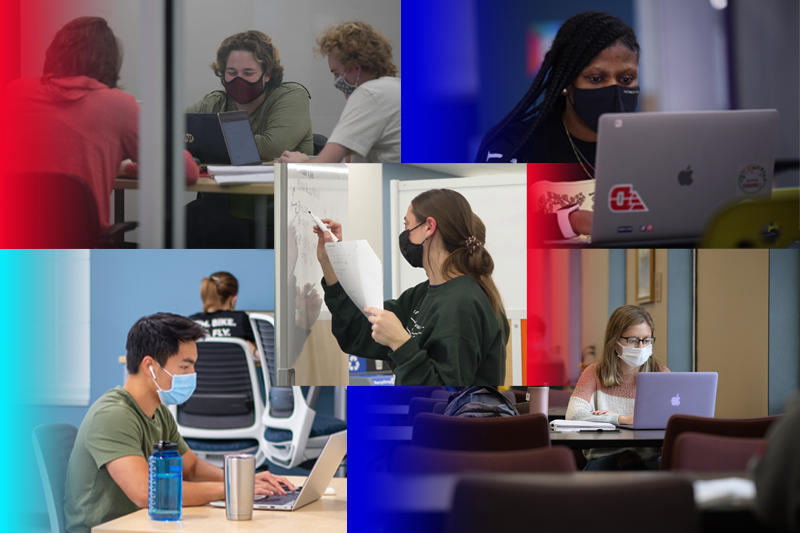University Libraries

Onward and Upward
By Katy Kelly
At the University of Dayton Libraries, we’ve anecdotally observed high use of library services and spaces. Data collected between September and November show that indeed, that’s what’s happening.
- An average of 1,586 people come through Roesch Library’s doors each day.
- Students made 22% more appointments than the same period in 2019 through our Book a Librarian research help service, which facilitates consultations between librarians and students.
- Reservations for library spaces such as study rooms increased 29% from the same time period in 2019.
Teaching, learning, gathering spaces
Our newly renovated first- and second-floor library spaces had just reopened in fall 2019, so this semester felt like somewhat of a relaunch of areas like Concourse D, the Gathering Place and the Collab, all located on the second floor. Concourse D and the Gathering Place were home to events, classes and lots of students working and studying.
The Collab, our classroom and event space, hosted many of this semester's library instruction sessions, primarily led by the librarians. The 156 instruction sessions demonstrate an overall increase in instruction — 22 percent more sessions in fall 2021 than fall 2019 and 44 percent more than fall 2020 — meaning more students received exposure to the vast resources available to them, which could be correlated to the statistics below.
Research, news, sources for information
Full study tables and groups of students in hallways and common areas provide visible evidence of library usage; just as telling are the statistics from the use of electronic collections continues to rise.
- This semester, the Libraries recorded the highest number of new registrations and active accounts for The New York Times online, access to which is jointly funded by the Libraries, SGA and the Provost’s Office.
- Compared to fall 2020, we've seen an 18% increase in the number of sessions across UDiscover and other popular discipline-specific databases. Compared to the same time period in fall 2019, sessions have increased 10%. This means students, faculty and staff are running more searches and using more electronic resources.
Archives: physical and digital
University archivists are busy, too — but they’ve been measuring their growth in linear feet and downloads:
- In 2021, archives received 188 linear feet of records and materials to be processed, both from departments and organizations at the University and about icons such as Erma Bombeck. This is in comparison to 63.5 linear feet in 2020.
- eCommons is the go-to online source to search and browse popular material in the University Archives and Special Collections. This fall brought increased downloads of the Daytonian yearbooks (2,579), Flyer News (1,143) and a neighborhood newsletter called Block Talk (246).
Data: Gauging success, informing strategy
Though hybrid instruction, physical distancing and decreased building hours made 2020 an anomaly, continuous data collection has been valuable for assessing the effectiveness of the Libraries in fulfilling our strategic plan to seamlessly connect information and services to users; contribute to UD's educational mission; and preserve the history of the University. These stories and statistics are evidence that our mission is in motion.
— Katy Kelly is associate professor and coordinator of marketing and engagement. Simon Robins, assistant professor and coordinator of electronic resources and discovery; Hector Escobar, associate professor and director of education and information delivery; and Heidi Gauder, professor and coordinator of research and instruction also contributed to this post. Photography by Jen Clark, Brigham Fisher and Mit Shah.
